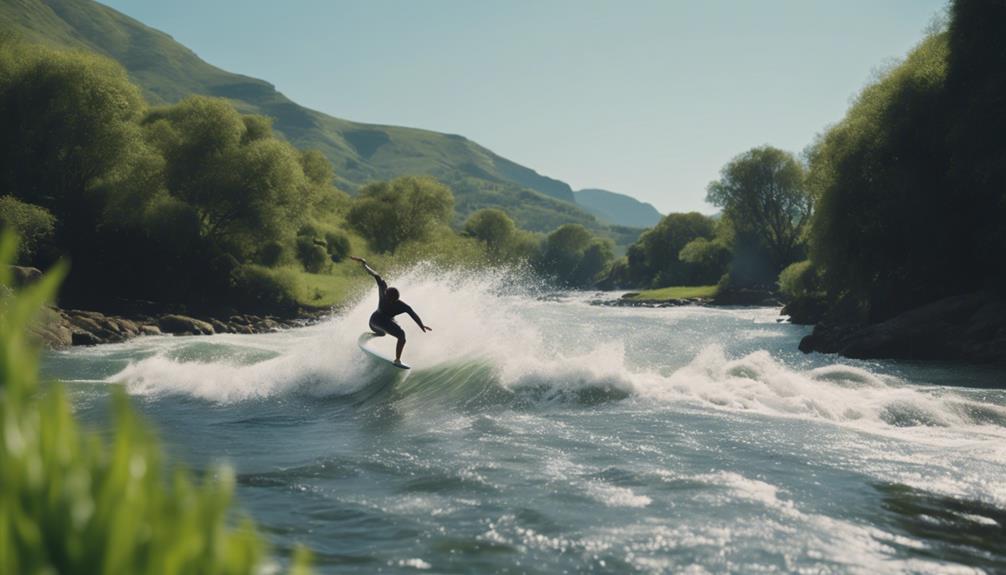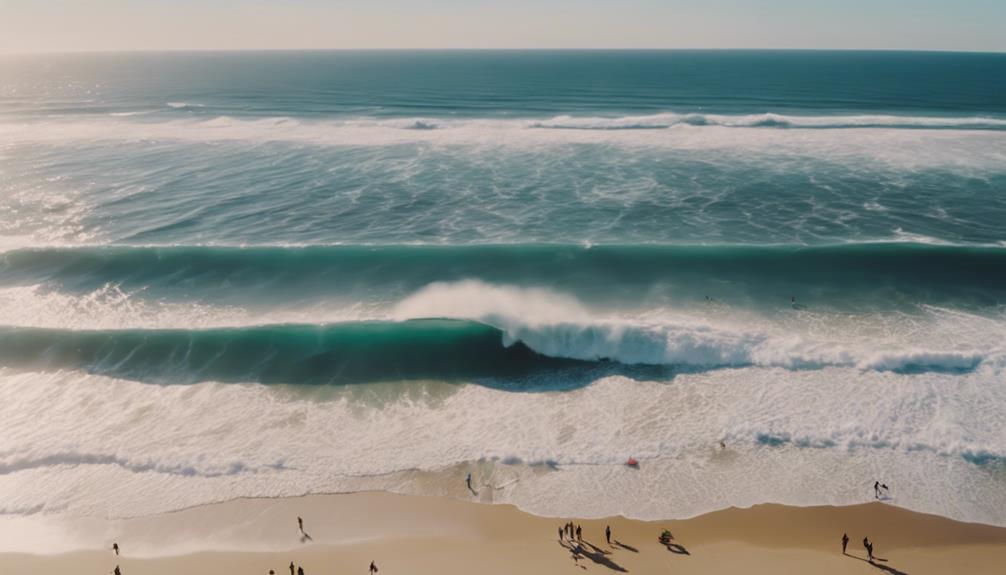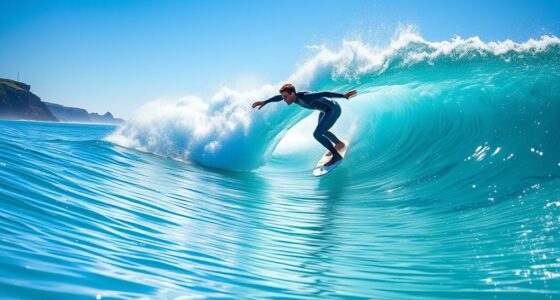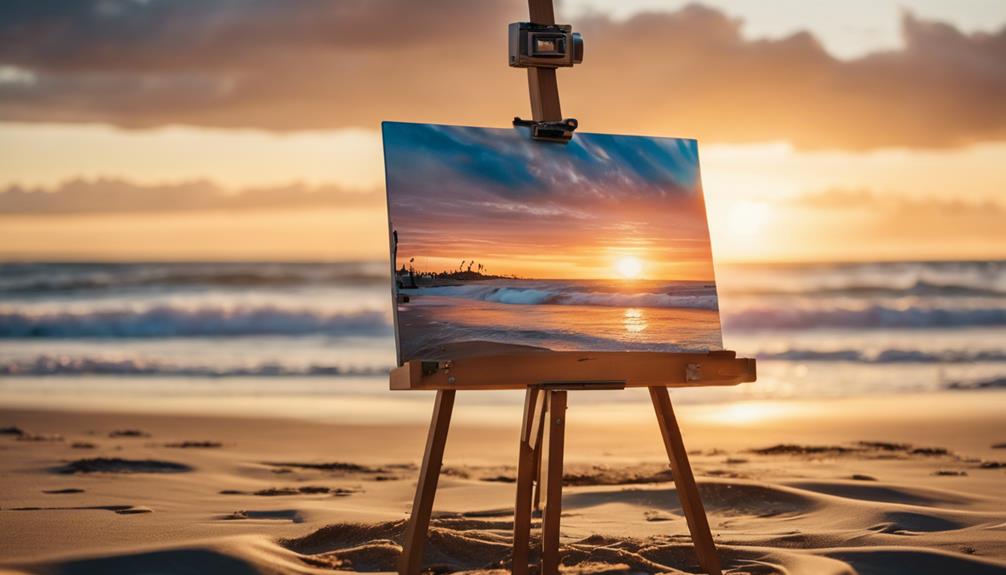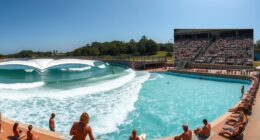If you're chasing big waves, the U.S. offers some of the tallest surf spots. Hawaii's North Shore features waves that can soar over 30 feet, especially during winter. Mavericks Beach in California is known for its massive swells, reaching between 25 to 80 feet in the winter months. Florida's coast also sees impressive waves during hurricane season, with sizes around 10 to 15 feet. Each location presents its own challenges and excitement. Are you curious about what makes these waves so enormous and the best times to surf them? Stick around, and you won't miss a thing!
Key Takeaways
- Hawaii's North Shore features some of the world's tallest surfing waves, exceeding 30 feet during the winter months.
- Mavericks Beach in California sees exhilarating winter waves ranging from 25 to 80 feet, attracting top surfers.
- Florida's East Coast can produce impressive swells of 10 to 15 feet, especially during hurricane season.
- Oregon's Nelscott Reef hosts waves around 30 feet, recognized for its Big Wave World Tour events.
Overview of Surfing Waves
Surfing waves in the U.S. can reach jaw-dropping heights, offering thrilling challenges for surfers of all skill levels.
From the roaring surf of Hawaii's Jaws (Peahi) to California's Mavericks, the diversity of wave conditions and locations creates a unique backdrop for surfers. Each wave tells its own story, much like an enchanting piece of music. You'll feel the rhythm as you paddle out, syncing your movements with the ocean's pulse.
During peak seasons, Hawaii showcases waves that can soar over 60 feet, while California's winter swells often exceed 25 feet, drawing in experienced surfers enthusiastic to test their skills. Florida's East Coast introduces a different vibe, where hurricane season can churn up waves reaching 10 to 15 feet, providing an exhilarating experience.
Oregon's Nelscott Reef, with its 30-foot waves, adds another layer to the symphony of surfing. The Big Wave World Tour even hosts competitions at these epic locations, adding to the excitement as surfers chase after waves that meet the strict criteria of 20 feet and above.
In every swell, you'll find a melody waiting to be surfed, a challenge that keeps you coming back for more.
Top Locations for Big Waves

When you're chasing big waves, Hawaii's North Shore is a must-visit, with its legendary breaks drawing surfers from all over.
California's Mavericks Beach offers thrilling rides with powerful swells that can take your breath away.
If you think Florida can't compete, think again—there are some impressive spots waiting for you there too.
Hawaii's Legendary North Shore
Hawaii's North Shore is a mecca for big wave enthusiasts, boasting some of the world's most formidable surf spots like Waimea Bay and the Banzai Pipeline. During the peak winter swells, you can witness waves towering over 30 feet, a sight that draws surfers from all corners of the globe. The Big Wave season, running from November through February, is particularly thrilling, featuring prestigious events like the Eddie Aikau Big Wave Invitational.
What sets the North Shore apart is its unique underwater topography, including deep channels and coral reefs, which creates powerful and challenging surf conditions. Sunset Beach, another iconic spot, is famous for its long rides and can produce waves ranging from 15 to 30 feet, making it a favorite for experienced surfers.
As you explore these legendary waters, you'll feel the spirit of the sport's pioneers, like Eddie Aikau and Gerry Lopez, who pushed the limits of big wave surfing here. Whether you're watching or riding, the North Shore offers an unparalleled experience that cements its status as the birthplace of big wave surfing.
California's Thrilling Mavericks Beach
Nestled along the California coast, Mavericks Beach in Half Moon Bay offers some of the most exhilarating waves in the world, attracting dedicated surfers seeking the ultimate challenge. During winter months, you'll see waves soaring between 25 to 80 feet, making it a premier destination for those craving adrenaline. The unique underwater topography plays a key role in creating these massive swells, drawing surfers and spectators from across the globe.
If you're planning to tackle Mavericks, be prepared for its challenges. The strong currents and cold water, averaging around 50°F, add a layer of difficulty and danger. Wipeouts can be brutal on the rocky seabed, so it's essential to respect the ocean and know your limits.
The annual Mavericks Surf Contest, which began in 1999, showcases the world's best big wave surfers. Events are held only when the conditions are considered ideal, adding an aura of exclusivity and excitement.
Mavericks isn't just a surfing spot; it's a cultural landmark that has greatly influenced the sport, inspiring a new generation to push the boundaries of wave riding. If you can handle the thrill, Mavericks Beach awaits you.
Florida's Big Wave Spots
Though Florida may not be the first place that comes to mind for big waves, it boasts impressive surf spots that can deliver exhilarating rides, especially during hurricane season.
The east coast's Sebastian Inlet and New Smyrna Beach often produce remarkable swells, with waves reaching 6 to 10 feet. These spots attract surfers keen for a challenge when storms roll in.
Cocoa Beach is another must-visit, known for its consistent surf and the annual East Coast Surfing Championships, where you can witness local talent riding big waves.
While Florida's waves mightn't rival those at California or Hawaii, unique reef breaks, particularly at Ponce Inlet, can produce powerful rides under the right conditions.
For the best experience, plan your surf trips from late summer to early fall. During this time, tropical storms and hurricanes are more frequent, generating ideal surfing conditions.
The Science Behind Huge Swells

When you think about huge swells, it's crucial to understand how oceanic waves form and the role of wind and weather.
Tides and currents interact to create the perfect conditions for those massive waves you love to ride.
Oceanic Wave Formation
Understanding how oceanic waves form requires recognizing the powerful role wind plays in transferring energy to the water's surface, creating the swells that surfers desire. When wind blows across the ocean, it generates friction with the water, which results in the formation of waves. The size of these waves largely depends on wind speed, duration, and fetch—the distance the wind travels over open water. Longer fetches allow waves to build more energy, leading to larger swells.
As swells travel across thousands of miles of ocean, they can gain significant size. When they approach shallow coastal areas, the ocean floor's topography causes them to rise dramatically, resulting in those massive surfing waves you seek. Additionally, the interaction between ocean currents and wind patterns can create favorable conditions for large swells, particularly in regions known for their surf, like Hawaii and California.
During winter months, powerful storms in the North Pacific generate intense swells that can exceed 100 feet! These conditions make it a thrilling time for surfers enthusiastic to tackle some of the highest waves in the U.S. Understanding this science helps you appreciate the beauty and power of oceanic waves.
Wind and Weather Influence
Massive swells are primarily shaped by wind patterns and weather systems, making them crucial factors for surfers chasing the biggest waves. When you consider how these swells form, three main aspects come into play:
- Wind Speed and Direction: Stronger winds generate larger swells. The speed and direction of the wind dictate how much energy is transferred to the water, creating the potential for massive waves.
- Weather Systems: Hurricanes and storms produce powerful wind patterns, leading to significant wave heights. On U.S. coasts, these systems can create waves exceeding 30 feet, providing thrilling conditions for advanced surfers.
- Fetch: The fetch is the distance over which the wind blows across the water. A longer fetch allows swells to build in size before reaching the shore, resulting in more powerful waves.
Coastal geography also plays a crucial role in how swells break. Underwater topography and the width of the continental shelf can amplify wave heights as they approach the shore.
During winter months, intensified storm systems along the Pacific coast increase wave activity, making it the prime season for big wave surfing.
Tides and Currents Interaction
Interacting with oceanic swells, tides, and currents dramatically influence the size and power of surfable waves along the coast. When you're out catching waves, it's vital to understand how these elements work together.
Tides can amplify or diminish wave heights depending on their phase, while currents can either enhance or hinder the energy of incoming swells.
The fetch—the distance over which wind blows—also plays a considerable role. Longer fetches typically generate larger swells that travel far and gain power. As these swells approach the coastline, underwater features like reefs and sandbars can steepen and focus the waves, creating those iconic, powerful breaks you love to ride.
Seasonal changes and storm patterns, especially hurricanes and winter storms, contribute to massive swells that can travel great distances. These events considerably impact surf conditions, making it vital for you to stay updated on the forecast.
Additionally, the Coriolis effect alters ocean current patterns, particularly in regions like Hawaii and California, enhancing the formation of large waves. Understanding these interactions can help you anticipate the best surf days and maximize your time in the water.
Notable Surfing Competitions

Among the most thrilling events in the surfing world, notable competitions showcase the incredible skill and bravery of surfers tackling some of the largest waves on the planet. These contests not only highlight the athleticism of participants but also the sheer power of nature.
Here are three of the most prestigious big wave competitions in the U.S.:
- Eddie Aikau Big Wave Invitational: Held at Waimea Bay, Hawaii, this event requires a minimum wave height of 20 feet, attracting top surfers ready to face challenging conditions.
- Mavericks Surf Contest: Located in California, this competition is famous for waves that can exceed 50 feet. It draws elite surfers from around the globe, challenging them with perilous surf.
- Jaws Big Wave Championship: Taking place at Peahi, Maui, this event features waves that can reach heights of up to 60 feet, solidifying its status as one of the most prestigious competitions in the big wave surfing calendar.
These competitions not only test surfers' limits but also push the boundaries of what's possible in the sport.
Safety Tips for Surfers

While competing in big wave contests showcases the thrill of surfing, safety should always come first when you hit the water.
Before you paddle out, check local surf conditions and weather reports. Wave heights and rip currents can change rapidly, so staying informed is essential. Make sure to know your skill level and choose surf spots that match your experience. This helps minimize the risk of injury.
Always wear a properly fitted leash to prevent losing your board, which can pose a hazard to yourself and others. If you're surfing in colder regions like California, consider using a wetsuit. It provides better insulation and protection against low ocean temperatures.
Lastly, never surf alone. Always surf with a buddy or in a group. Having someone nearby can be a lifesaver in emergencies or unexpected situations.
Legendary Surfers and Their Stories
Throughout surfing history, legendary surfers have pushed the boundaries of the sport, each with their own incredible stories and feats that inspire new generations. From massive waves to groundbreaking techniques, these surfers have changed the game.
Here are three iconic figures and their remarkable contributions:
- Laird Hamilton: Known for his fearless approach, Laird rides the colossal waves at Jaws in Hawaii, where swells can exceed 60 feet. His innovative techniques have transformed big wave surfing.
- Kelly Slater: An 11-time world champion, Kelly has redefined big wave surfing with his historic rides at Teahupo'o, Tahiti. His mastery of the sport has influenced countless surfers and continues to raise the bar.
- Greg Noll: A pioneer of big wave surfing in the 1960s, Greg, known as 'Da Cat,' famously conquered the towering waves at Waimea Bay. His daring spirit and groundbreaking rides paved the way for future surfers.
These legends, among others, have shaped the surfing landscape, pushing the limits and inspiring you to embrace the thrill of the waves.
Environmental Impact on Surfing

Climate change's impact on ocean temperatures is reshaping wave patterns, making it crucial for surfers to understand how these changes could affect their favorite spots. As ocean temperatures rise, you're likely to notice shifts in wave frequency and size, especially at iconic locations like Mavericks and Waimea Bay. Coastal erosion, worsened by rising sea levels, can alter the very characteristics of these waves.
Here's a quick overview of how environmental factors are influencing surfing:
| Factor | Impact on Surfing | Example Locations |
|---|---|---|
| Rising Ocean Temperatures | Alters wave patterns and frequency | California Coast |
| Coastal Erosion | Changes wave characteristics | Mavericks, Waimea Bay |
| Pollution | Affects marine ecosystems and surf quality | East Coast beaches |
| Ocean Currents | Impacts size and consistency of waves | Hawaii |
| Habitat Loss | Diminishes protective barriers | Coral reef breaks |
As you ride the waves, consider how these environmental changes could shape your future surfing experiences. Keeping an eye on these factors guarantees you stay informed and ready for whatever the ocean has in store.
Future of Big Wave Surfing

As advancements in technology and changing environmental conditions reshape the landscape, the future of big wave surfing looks more thrilling than ever. You can expect to see significant changes that will elevate the sport in various ways. Here are three key aspects shaping the future of big wave surfing:
- Improved Technology: Enhanced forecasting models and innovative surfboard designs enable you to tackle larger waves with greater confidence and skill.
- Environmental Changes: Climate change and shifting ocean patterns are likely to create more frequent and extreme wave conditions, increasing the size and frequency of big waves you might encounter.
- Growing Competitions: Upcoming years may see a rise in big wave surfing competitions, with more surf spots like Nazaré in Portugal and Jaws in Hawaii gaining recognition for their potential.
Additionally, safety measures are evolving, introducing equipment like inflatable vests and jet ski rescue teams to support surfers in perilous conditions.
The growing popularity of big wave surfing is attracting a new generation, diversifying the sport and boosting participation in competitive and recreational surfing.
Embrace these changes and get ready for an exhilarating ride!
Frequently Asked Questions
Where Are the Highest Surfing Waves in the Us?
You'll find the highest surfing waves in the U.S. primarily at Jaws in Maui, Mavericks in California, and Waimea Bay in Oahu. Each location offers thrilling challenges for adventurous surfers during peak swell seasons.
Where Are the Biggest Waves on the North Shore?
Imagine a mighty dragon releasing its fury upon the shore; that's what the North Shore offers. You'll find Waimea Bay, Pipeline, and Sunset Beach, where colossal waves await your surfboard and your adventurous spirit.
How Big Were the Waves at Mavericks?
At Mavericks, you'll encounter waves that typically range from 25 to 50 feet, especially during winter. Some exceptional swells can reach up to 60 feet, making it a challenging spot for even seasoned surfers like you.
Why Is California Getting Big Waves?
California's getting big waves because of its unique coastal geography, powerful Pacific storms, and weather patterns like El Niño. These factors combine to create ideal conditions for massive swells, attracting surfers enthusiastic for excitement.
Are the highest surfing waves in the US comparable to the largest surfing waves in the world?
The largest surfing waves world giants are found in different locations around the world. While the US is known for its impressive waves, they may not be on par with the absolute largest in the world. Famous surfing spots like Hawaii’s Banzai Pipeline and Portugal’s Nazaré boast some of the biggest waves globally.
Conclusion
As you chase the thrill of the ocean's mighty waves, remember that each ride is a dance with nature's power.
The peaks you conquer aren't just proofs of your skill but also reminders of the fragile beauty that surrounds us.
So, whether you're paddling out at Mavericks or catching a break in Hawaii, cherish the experience.
After all, in the grand tapestry of surfing, every wave tells a story—one that's waiting for you to write.



